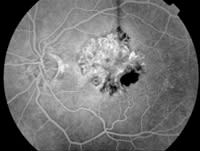First Things First
Smart tactics and tools for educating patients about AMD.
"When a patient comes in with macular degeneration, you have to explain the disease before you can talk about treatment," says Jason S. Slakter, M.D. Ophthalmologists have been offering this explanation for many years, but advances in diagnosis and understanding of the disease are perpetually changing it. The changes are felt by physicians, as well as staff members outside the exam room.
Panel members shared their education approaches and the tools they use to give patients a clear picture.

"The most effective teaching aid I have is a digital angiogram on a large screen," says Dr. Fineman. "There's nothing more helpful to patients than actually seeing the abnormal blood vessels and the leakage revealed by the dye while I describe the disease. Most patients feel much more comfortable when they see the angiogram, and I can easily help them understand where the leakage is and to what degree I can stop it."
Dr. Fineman describes the fundamentals of AMD, including the difference between dry and wet AMD. Most of his patients have choroidal neovascularization (CNV); to avoid overwhelming his patients, he keeps his explanations of CNV fairly simple.
"I really don't get into the specifics, like differentiating between classic and occult lesions, unless it's necessary," he says. "I present the information in a straightforward way, such as 'CNV is a problem whereby abnormal blood vessels grow in an eye that's already affected by dry AMD. And treatment has two aspects: 1) to alleviate some of the fluid leakage, if possible; and 2) to cause regression of the abnormal blood vessels.'"
Next, Dr. Fineman discusses risk factors, such as smoking and sun exposure. He helps patients understand the importance of protecting the fellow eye from wet AMD and following the prescribed vitamin therapy.
|
|
|
|
"The most effective teaching aid I have is a digital angiogram on a large screen," says Mitchell S.
Fineman, M.D. |
Mark Hughes, M.D.
In all good communication, especially patient education, it helps to evaluate not only the information you deliver but also how it is received.
"We encourage patients to bring a son or daughter or other relative to help patients understand," says Mark Hughes, M.D.
Dr. Hughes finds that simplicity and repetition deliver the best results.
"In the last few years, I've seen patients who are much more knowledgeable about AMD than they were just 5 years ago," he says. "But for many patients, AMD is still new. I think the more they hear about it from my staff and me, the more comfortable they feel."
His patients learn about AMD during every step of their visits, from the technician to the scribe. "Patients receive a brochure at check-in, and often the relative will read it. That gives them both time to formulate questions before I see them," Dr. Hughes says.
"In the exam room, we discuss that age and genetics are the two biggest risk factors," he says. "I tell patients, 'We can't modify these things. We can make you look younger, but we can't make your macula younger.' And then we cover all the basics of smoking, hypertension, diet, vitamins and antioxidants."
If the patient goes on for an angiogram, the nurse and the photographer repeat Dr. Hughes's words. This way, patients hear the same message two or three times in one visit.
Like Dr. Fineman, Dr. Hughes shows patients their fluorescein angiograms and compares them to a normal angiogram. Combined with illustrated literature, this gives patients a complete picture.
|
But Are They Listening? |
|
Is your patient education working? You probably get a good sense of this just by dealing with patients and hearing their questions about verteporfin therapy. However, certain signs will point to weaknesses in a practice's patient education process. Watch for these red flags, which could affect your practice's efficiency:
|
|
Jamieson R. Holmes
Dr. Hughes's invitation to family members isn't unique. In fact, some physicians take extra steps to invite family and help them understand the need for treatment.
"We try to involve the family as much as possible," says Jamieson R. Holmes. "We've found it's very beneficial to show family members a simulated image of what an object looks like when a person has macular degeneration -- a typical photo with the black dot in the middle. This helps everyone understand why mom can pick up the car keys from the table, but she can't read a book."
Mr. Holmes also shows patients and their families brochures and the fluorescein angiogram images, which can be displayed on monitors in each exam room.
Mr. Holmes also uses staff to make sure all the patient's questions get answered. "The physician initiates the discussion," he explains, "and then the medical assistant follows up later to answer any additional questions. We do a lot of our PDT treatments the same day. Questions often arise after the patient has had time to digest the information and she's waiting for treatment. The medical assistant is there to answer many of these questions."
The groundwork is laid
You've explained AMD. You've trained your staff to help. You've made sure your patients' questions will be answered as they arise. Your patients and their families understand the need for treatment. At this point, most of the work of education is done. And if verteporfin therapy is an option for a patient, the conversations that follow will represent a shift from information to positive action.
|
FAST FIVE |
What's Most Important for Educating Patients About Verteporfin Therapy? Mitchell S.
Fineman, M.D. Charity Stout, R.N. Patty
Gumina, R.N. Jamieson R. Holmes Mark Hughes, M.D. |









